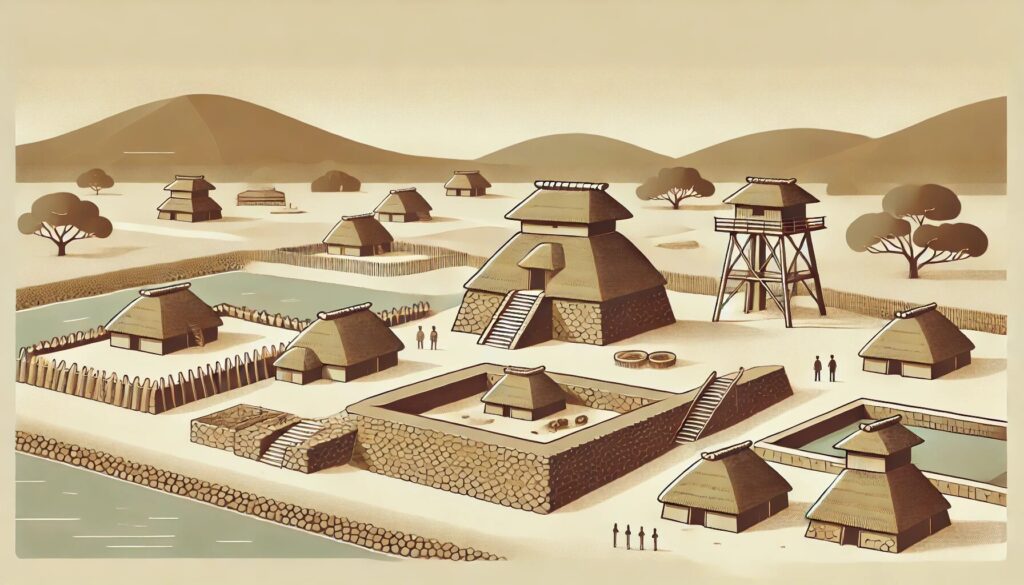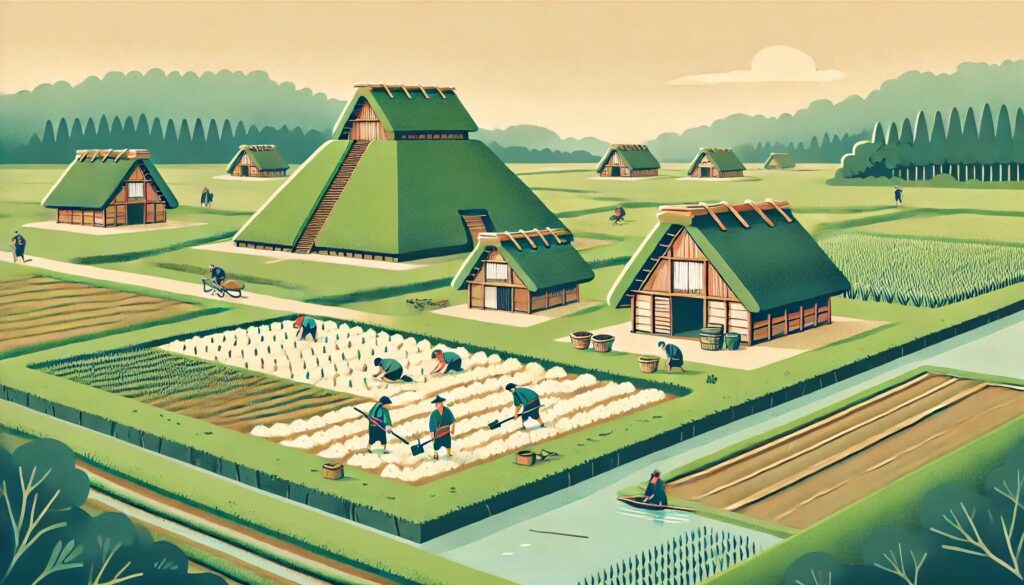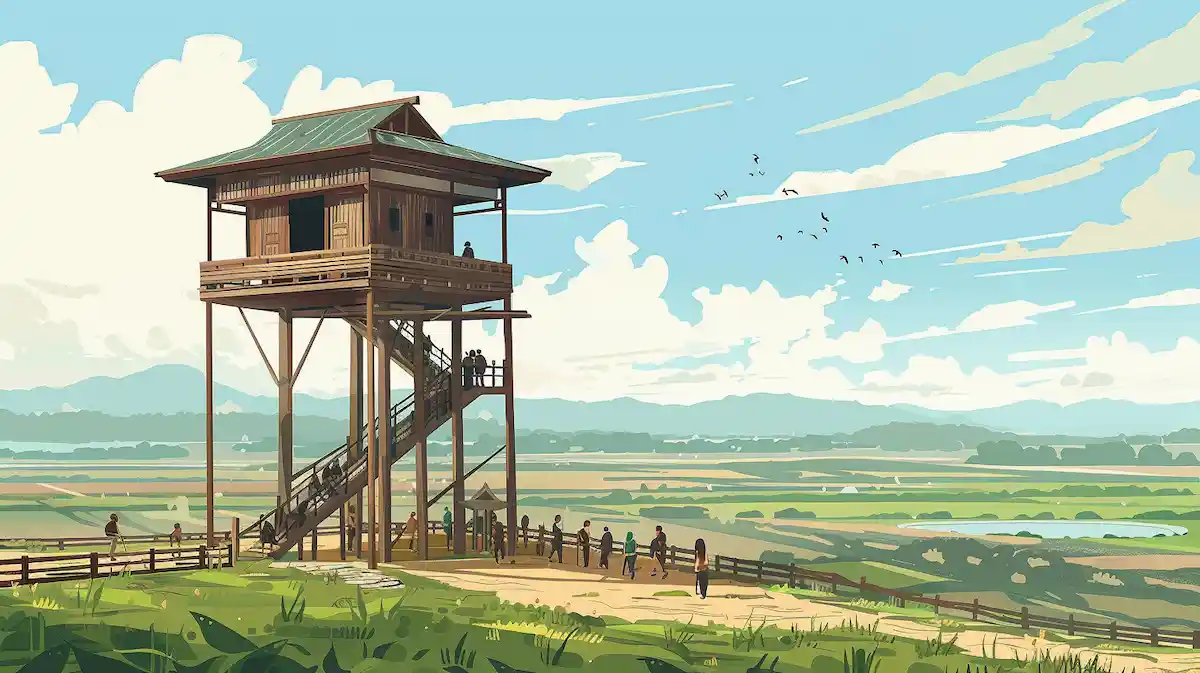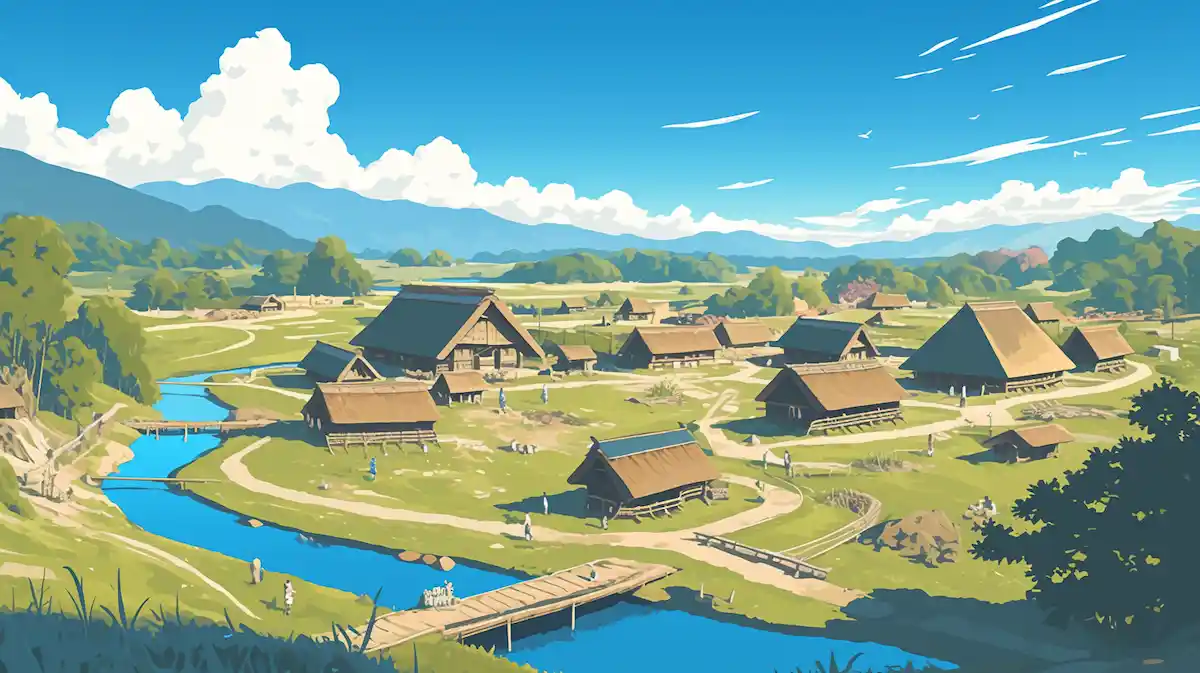弥生時代を英語で説明・紹介するための基本情報と、英会話に役立つ表現をシンプルでわかりやすい英語で紹介します。
英会話ダイアローグ・概要・10の質問を通して、弥生時代に関する英語表現を学びます。
英語
英会話ダイアローグを読む前に知っておくと良い前提知識と情報です。
- 弥生時代の基本情報
- 紀元前4世紀頃から紀元後3世紀頃まで
- 水田での稲作が始まり、定住生活が一般化
- 鉄器(農具・工具)や青銅器(祭器)の使用
- 階層社会が始まり、環濠(堀)を持つ村の出現
- 弥生時代の生活と文化
- 弥生土器: 薄くて丈夫、装飾が少なく実用的なデザイン、主に調理や保存に使用
- 住居: 竪穴住居が主流、村単位で生活
- 宗教と祭祀: 自然崇拝や祖先崇拝があり、銅鐸や銅剣などを祭儀で使用
- 弥生時代の遺跡と埋葬方法
- 吉野ヶ里遺跡(佐賀県): 防御集落の代表例、再現された住居や見張り塔が見られる
- 登呂遺跡(静岡県): 水田跡や農具が発見されており、弥生時代の農業を知る重要な遺跡
- 埋葬方法
- 甕棺墓: 大きな壺に遺体を収める
- 方形周溝墓: 四角い堀を持つ墓
- 埋葬形式は社会的地位によって異なる
- 弥生時代と他国との交流
- 中国や朝鮮半島から稲作や金属器の技術が伝来
- 現代の貿易とは異なり、限定的な物資の移動や技術の伝播が中心
- 弥生時代が日本史において重要な理由
- 弥生時代は、狩猟採集中心だった縄文時代から農耕中心の社会へと移行した転換期
- この時期に形成された社会構造や文化は、その後の日本の基盤を築くものとなった
2人が弥生時代について話しています。
稲作の始まり、土器の特徴、集落の発展、階級社会の形成、対外交流、代表的な遺跡、埋葬方法などを話題にしています。
会話 / dialogue

Hey Key, I’ve been reading about Japanese history recently, and I came across the Yayoi Period. It sounds fascinating, but I feel like I don’t fully understand it. Can you tell me more?

Sure! The Yayoi Period is a really important part of Japanese history. It lasted from around the 4th century BCE to the 3rd century CE, so about 600 years. What have you learned so far?

Not much. I know it came after the Jomon Period, but what made it so different?

The biggest change was rice farming. During the Yayoi Period, people began growing rice in wet fields. This allowed them to settle in one place and form larger, organized villages.

So they moved away from hunting and gathering?

Exactly. Farming required a lot of cooperation, so people started working together in villages. With this, life became more stable, and the population grew.

That’s interesting. I also read about Yayoi pottery. How was it different from the Jomon pottery?

Yayoi pottery was simpler and more practical. It was thinner and used mainly for cooking and storing food, especially rice. In contrast, Jomon pottery was often more decorative.

That makes sense. So, with farming and larger villages, I guess their society changed a lot too?

Yes, society became more organized. Some people took leadership roles, organizing farming or protecting the village. Others worked in the fields. It wasn’t as strict as modern social classes, but you can see the early stages of hierarchy forming.

Did they need protection? Were there conflicts?

There were! Some villages built moats around their settlements for defense. For example, at Yoshinogari in Saga Prefecture, you can see reconstructed moats and watchtowers. It shows they were prepared for conflicts, possibly over resources like rice.

Yoshinogari… I’d love to visit that site. What else can you see there?

It’s amazing! You can explore reconstructed houses, storage buildings, and even burial sites. It gives you a clear picture of how people lived during the Yayoi Period.

Speaking of burials, what kind of graves did they use?

They had a variety of burial styles. For example, pot burials, where bodies were placed in large jars. But they also had square moated graves and stone graves. The differences in burial styles often reflected the person’s social status.

That’s fascinating. And what about tools? Were they still using stone tools like in the Jomon Period?

Not really. During the Yayoi Period, they started using iron tools for farming and daily tasks, which made work much more efficient. They also used bronze tools for rituals and ceremonies.

Where did they get iron and bronze? Was it from Japan?

No, those materials and technologies were introduced through limited cultural exchanges with China and Korea. It wasn’t “trade” like we think of today, but they learned a lot through these interactions.

Wow, so the Yayoi Period was really the beginning of Japan connecting with other countries.

Exactly. It’s also the period when Japan started to develop its own identity, combining influences from abroad with local traditions.

It sounds like such an important time. I can’t believe I didn’t know more about it. Thanks for explaining, Key.

No problem, Mack! If you want to explore more, Yoshinogari is a great start. There’s also the Toro site in Shizuoka, where they found old rice paddies and farming tools.

That sounds incredible. I’ll add both to my travel list. Thanks again for all the info!

Anytime! Let me know if you want to talk more about Japanese history. It’s always fun to share.
概要 / Overview
「弥生時代」について、理解を深めるための「英語での概要」です。
弥生時代

Introduction to the Yayoi Period
The Yayoi Period is an important part of Japanese history. It lasted from around the 4th century BCE to the 3rd century CE, following the Jomon Period. This time brought many changes, such as farming, metal tools, and organized villages. It was the start of a more structured society that would influence Japan’s future.
The Start of Rice Farming
One of the biggest changes during the Yayoi Period was the introduction of rice farming. People began growing rice in wet fields, which allowed them to settle in one place instead of moving around to hunt and gather. Farming required cooperation, so people formed villages and worked together. This led to a stable food supply and a growing population.
New Tools and Technology
The Yayoi people used new tools made from iron and bronze. Iron tools were helpful for farming and everyday tasks, making work faster and easier. Bronze tools were not used for farming but were important for rituals and ceremonies. These new tools and materials likely came from China and Korea through cultural exchanges.
Changes in Society
As farming became more common, society became more organized. Some people took leadership roles, organizing farming or protecting villages. This was the beginning of social classes, where some people had more power and wealth than others. Villages also started to build moats around their settlements to protect themselves from conflicts, often over resources like rice.
Yayoi Pottery and Daily Life
The Yayoi people made simpler and thinner pottery compared to the decorative pottery of the Jomon Period. Yayoi pottery was practical, used for cooking and storing food, especially rice. People lived in pit houses, small homes dug into the ground, and their main food was rice, with fish and plants as side dishes.
Important Yayoi Sites
There are many archaeological sites from the Yayoi Period. Yoshinogari in Saga Prefecture is a famous example. It shows what a Yayoi village looked like, with reconstructed houses, storage buildings, and moats. Another site, Toro in Shizuoka Prefecture, has ancient rice fields and farming tools.
Conclusion
The Yayoi Period was a time of great change in Japan. It marked the shift from a hunting and gathering society to a farming society with social organization. The tools, farming techniques, and cultural exchanges from this time laid the foundation for later Japanese culture and history.
10の質問 / 10 questions
「弥生時代」について、理解を深めるための「英語での10の質問」です。
1: What is the Yayoi Period?
The Yayoi Period is a time in Japanese history from around the 4th century BCE to the 3rd century CE. It followed the Jomon Period and introduced farming, metal tools, and organized villages.
2: What was the biggest change during the Yayoi Period?
The biggest change was the start of rice farming in wet fields. This allowed people to settle in one place and form larger, stable villages.
3: What tools did the Yayoi people use?
They used iron tools for farming and daily tasks, and bronze tools for rituals and ceremonies. These tools were introduced through cultural exchanges with China and Korea.
4: How was Yayoi pottery different from Jomon pottery?
Yayoi pottery was thinner and simpler, designed for practical uses like cooking and storing food. Jomon pottery was more decorative and artistic.
5: What kind of homes did people live in during the Yayoi Period?
People lived in pit houses, which were small homes dug into the ground. These homes helped protect them from cold weather.
6: How did society change in the Yayoi Period?
Society became more organized with the start of social classes. Leaders managed farming and village protection, while others worked in fields.
7: Why did some Yayoi villages build moats?
Villages built moats around their settlements for defense against conflicts, often over resources like rice.
8: What burial methods were used in the Yayoi Period?
They used various methods, including pot burials, square moated graves, and stone graves. These often reflected a person’s social status.
9: What are some famous Yayoi archaeological sites?
Yoshinogari in Saga Prefecture is famous for its reconstructed villages, and Toro in Shizuoka Prefecture is known for its ancient rice fields and farming tools.
10: Why is the Yayoi Period important in Japanese history?
It marked the transition from a hunting and gathering society to a farming society with social organization, laying the foundation for later Japanese culture and history.

和訳付
会話 / dialogue

Hey Key, I’ve been reading about Japanese history recently, and I came across the Yayoi Period. It sounds fascinating, but I feel like I don’t fully understand it. Can you tell me more?
ねえキー、最近日本の歴史について読んでいて、弥生時代っていうのを見つけたんだ。面白そうだけど、まだ完全には理解できていない気がする。詳しく教えてくれる?

Sure! The Yayoi Period is a really important part of Japanese history. It lasted from around the 4th century BCE to the 3rd century CE, so about 600 years. What have you learned so far?
もちろん!弥生時代は日本の歴史においてすごく重要な時期だよ。紀元前4世紀頃から紀元後3世紀頃までの約600年間続いたんだ。今のところ何を学んだ?

Not much. I know it came after the Jomon Period, but what made it so different?
あまり多くは知らないけど、縄文時代の後に来た時代だってことはわかってる。それがどう違うの?

The biggest change was rice farming. During the Yayoi Period, people began growing rice in wet fields. This allowed them to settle in one place and form larger, organized villages.
一番大きな変化は稲作だよ。弥生時代には人々が水田で稲を育て始めたんだ。それによって一箇所に定住できるようになって、より大きくて組織的な村を作ることができたんだよ。

So they moved away from hunting and gathering?
じゃあ、狩猟採集の生活から離れたってこと?

Exactly. Farming required a lot of cooperation, so people started working together in villages. With this, life became more stable, and the population grew.
その通り。農業にはたくさんの協力が必要だったから、人々は村で一緒に働き始めたんだ。それで生活が安定して、人口も増えていったんだよ。

That’s interesting. I also read about Yayoi pottery. How was it different from the Jomon pottery?
面白いね。それと弥生土器についても読んだけど、縄文土器とはどう違ったの?

Yayoi pottery was simpler and more practical. It was thinner and used mainly for cooking and storing food, especially rice. In contrast, Jomon pottery was often more decorative.
弥生土器はもっとシンプルで実用的だったよ。薄くて主に料理や食べ物、特にお米の保存に使われていたんだ。それに対して、縄文土器は装飾的なものが多かった。

That makes sense. So, with farming and larger villages, I guess their society changed a lot too?
なるほどね。それで農業や大きな村ができたことで、社会も大きく変わったのかな?

Yes, society became more organized. Some people took leadership roles, organizing farming or protecting the village. Others worked in the fields. It wasn’t as strict as modern social classes, but you can see the early stages of hierarchy forming.
そうだね。社会がより組織的になったんだ。一部の人は農業をまとめたり村を守ったりするリーダー的な役割を担った。一方で他の人たちは田んぼで働いていたんだ。今のような厳密な階級ではないけど、階層の始まりが見られるよ。

Did they need protection? Were there conflicts?
防御が必要だったの?争いがあったの?

There were! Some villages built moats around their settlements for defense. For example, at Yoshinogari in Saga Prefecture, you can see reconstructed moats and watchtowers. It shows they were prepared for conflicts, possibly over resources like rice.
あったよ!いくつかの村では、防御のために集落の周りに堀を作ったんだ。例えば、佐賀県の吉野ヶ里では再現された堀や見張り塔を見ることができるよ。それは、おそらくお米などの資源をめぐる争いに備えていたことを示しているんだ。

Yoshinogari… I’d love to visit that site. What else can you see there?
吉野ヶ里か…ぜひ行ってみたいな。他にはどんなものが見られるの?

It’s amazing! You can explore reconstructed houses, storage buildings, and even burial sites. It gives you a clear picture of how people lived during the Yayoi Period.
素晴らしいよ!再現された住居や倉庫、それに埋葬地まで見ることができるんだ。弥生時代の人々がどうやって暮らしていたのかがはっきりわかるよ。

Speaking of burials, what kind of graves did they use?
埋葬の話だけど、どんなお墓を使っていたの?

They had a variety of burial styles. For example, pot burials, where bodies were placed in large jars. But they also had square moated graves and stone graves. The differences in burial styles often reflected the person’s social status.
埋葬の方法はいろいろあったよ。例えば、大きな壺に遺体を収める甕棺墓(かめかんぼ)があったり、方形周溝墓(ほうけいしゅうこうぼ)や支石墓(しせきぼ)もあったんだ。お墓の形式の違いは、亡くなった人の社会的な地位を反映していることが多かったよ。

That’s fascinating. And what about tools? Were they still using stone tools like in the Jomon Period?
すごく興味深いね。それと道具はどうだったの?縄文時代みたいに石器をまだ使っていたの?

Not really. During the Yayoi Period, they started using iron tools for farming and daily tasks, which made work much more efficient. They also used bronze tools for rituals and ceremonies.
そうでもないよ。弥生時代には農業や日常の作業に鉄器を使い始めて、作業がずっと効率的になったんだ。それから、青銅器は儀式や祭りで使われていたんだよ。

Where did they get iron and bronze? Was it from Japan?
鉄や青銅ってどこから手に入れたの?日本国内のものだったの?

No, those materials and technologies were introduced through limited cultural exchanges with China and Korea. It wasn’t “trade” like we think of today, but they learned a lot through these interactions.
いや、それらの材料や技術は中国や朝鮮半島との限定的な文化交流を通じて伝わったんだ。今のような「貿易」とは違うけど、そうした交流からたくさんのことを学んだんだよ。

Wow, so the Yayoi Period was really the beginning of Japan connecting with other countries.
へえ、じゃあ弥生時代は日本が他の国とつながり始めた時期だったんだね。

Exactly. It’s also the period when Japan started to develop its own identity, combining influences from abroad with local traditions.
その通り。それに、弥生時代は日本が海外の影響を取り入れつつ、自分たち独自の文化を発展させ始めた時期でもあるんだ。

It sounds like such an important time. I can’t believe I didn’t know more about it. Thanks for explaining, Key.
すごく重要な時期だね。もっと知らなかったのが信じられないよ。説明してくれてありがとう、キー。

No problem, Mack! If you want to explore more, Yoshinogari is a great start. There’s also the Toro site in Shizuoka, where they found old rice paddies and farming tools.
どういたしまして、マック!もっと探求したいなら、吉野ヶ里から始めるのがいいよ。それと、静岡の登呂遺跡もおすすめだよ。そこでは古代の水田や農具が発見されているんだ。

That sounds incredible. I’ll add both to my travel list. Thanks again for all the info!
すごいな。その2つを旅行リストに加えておくよ。改めてありがとう!

Anytime! Let me know if you want to talk more about Japanese history. It’s always fun to share.
いつでも!日本の歴史についてもっと話したくなったら教えてね。話すのはいつも楽しいよ。
概要 / Overview
弥生時代

Introduction to the Yayoi Period
The Yayoi Period is an important part of Japanese history. It lasted from around the 4th century BCE to the 3rd century CE, following the Jomon Period. This time brought many changes, such as farming, metal tools, and organized villages. It was the start of a more structured society that would influence Japan’s future.
弥生時代は、日本の歴史において重要な時期です。紀元前4世紀頃から紀元後3世紀頃まで続き、縄文時代の後に訪れました。この時期には、農業、金属器の使用、組織化された村など、多くの変化が起こりました。これは、後の日本社会に影響を与える、より構造化された社会の始まりでした。
The Start of Rice Farming
One of the biggest changes during the Yayoi Period was the introduction of rice farming. People began growing rice in wet fields, which allowed them to settle in one place instead of moving around to hunt and gather. Farming required cooperation, so people formed villages and worked together. This led to a stable food supply and a growing population.
弥生時代で最も大きな変化の一つは、稲作の導入です。人々は水田で稲を育て始め、狩猟採集のために移動する生活をやめて、定住できるようになりました。農業には協力が必要だったため、村を作り、一緒に働くようになりました。これにより、食料が安定的に供給され、人口が増加しました。
New Tools and Technology
The Yayoi people used new tools made from iron and bronze. Iron tools were helpful for farming and everyday tasks, making work faster and easier. Bronze tools were not used for farming but were important for rituals and ceremonies. These new tools and materials likely came from China and Korea through cultural exchanges.
弥生時代の人々は、鉄と青銅で作られた新しい道具を使用しました。鉄器は農業や日常の作業に役立ち、作業をより早く、簡単にしました。青銅器は農業には使われませんでしたが、儀式や祭りにおいて重要な役割を果たしました。これらの道具や材料は、中国や朝鮮半島との文化交流を通じて伝わったと考えられます。
Changes in Society
As farming became more common, society became more organized. Some people took leadership roles, organizing farming or protecting villages. This was the beginning of social classes, where some people had more power and wealth than others. Villages also started to build moats around their settlements to protect themselves from conflicts, often over resources like rice.
農業が普及するにつれて、社会はより組織化されました。一部の人々は農業をまとめたり、村を守ったりするリーダーの役割を担うようになりました。これが、力や富を持つ人とそうでない人が分かれる社会階層の始まりでした。また、村はお米のような資源を巡る争いから身を守るため、集落の周りに堀を築くようになりました。
Yayoi Pottery and Daily Life
The Yayoi people made simpler and thinner pottery compared to the decorative pottery of the Jomon Period. Yayoi pottery was practical, used for cooking and storing food, especially rice. People lived in pit houses, small homes dug into the ground, and their main food was rice, with fish and plants as side dishes.
弥生時代の人々は、縄文時代の装飾的な土器と比べて、よりシンプルで薄い土器を作りました。弥生土器は実用的で、料理や食べ物、特にお米の保存に使われました。人々は竪穴住居と呼ばれる、地面に掘られた小さな家に住んでおり、主食はお米で、魚や植物を副食として食べていました。
Important Yayoi Sites
There are many archaeological sites from the Yayoi Period. Yoshinogari in Saga Prefecture is a famous example. It shows what a Yayoi village looked like, with reconstructed houses, storage buildings, and moats. Another site, Toro in Shizuoka Prefecture, has ancient rice fields and farming tools.
弥生時代の遺跡はたくさんあります。佐賀県の吉野ヶ里は有名な例で、再現された住居や倉庫、堀を見ることができます。これにより、弥生時代の村がどのようなものだったかが分かります。また、静岡県の登呂遺跡では、古代の水田や農具が発見されています。
Conclusion
The Yayoi Period was a time of great change in Japan. It marked the shift from a hunting and gathering society to a farming society with social organization. The tools, farming techniques, and cultural exchanges from this time laid the foundation for later Japanese culture and history.
弥生時代は、日本で大きな変化が起こった時期です。狩猟採集社会から農業社会への移行が進み、社会の組織化が始まりました。この時期の道具、農業技術、文化交流は、後の日本の文化と歴史の基盤を築くものとなりました。
10の質問 / 10 questions
1: What is the Yayoi Period?
弥生時代とは何ですか?
The Yayoi Period is a time in Japanese history from around the 4th century BCE to the 3rd century CE. It followed the Jomon Period and introduced farming, metal tools, and organized villages.
弥生時代は、紀元前4世紀頃から紀元後3世紀頃まで続く日本の歴史の一時期です。縄文時代に続き、農業、金属器、組織化された村が導入されました。
2: What was the biggest change during the Yayoi Period?
弥生時代で最も大きな変化は何ですか?
The biggest change was the start of rice farming in wet fields. This allowed people to settle in one place and form larger, stable villages.
最も大きな変化は、水田での稲作の始まりです。これにより、人々は一箇所に定住し、より大きく安定した村を作ることができました。
3: What tools did the Yayoi people use?
弥生時代の人々はどのような道具を使いましたか?
They used iron tools for farming and daily tasks, and bronze tools for rituals and ceremonies. These tools were introduced through cultural exchanges with China and Korea.
人々は、農業や日常の作業に鉄器を、儀式や祭りには青銅器を使用しました。これらの道具は、中国や朝鮮半島との文化交流を通じて伝えられました。
4: How was Yayoi pottery different from Jomon pottery?
弥生土器は縄文土器とどのように違いましたか?
Yayoi pottery was thinner and simpler, designed for practical uses like cooking and storing food. Jomon pottery was more decorative and artistic.
弥生土器は、薄くてシンプルで、料理や食べ物の保存といった実用的な用途向けに作られていました。縄文土器は、より装飾的で芸術的でした。
5: What kind of homes did people live in during the Yayoi Period?
弥生時代の人々はどのような家に住んでいましたか?
People lived in pit houses, which were small homes dug into the ground. These homes helped protect them from cold weather.
人々は竪穴住居に住んでいました。それは地面に掘られた小さな家で、寒い天候から身を守るのに役立ちました。
6: How did society change in the Yayoi Period?
弥生時代には社会はどのように変化しましたか?
Society became more organized with the start of social classes. Leaders managed farming and village protection, while others worked in fields.
社会は階層社会の始まりとともに、より組織的になりました。リーダーたちは農業や村の防衛を管理し、他の人々は田畑で働きました。
7: Why did some Yayoi villages build moats?
なぜ弥生時代のいくつかの村は堀を作ったのですか?
Villages built moats around their settlements for defense against conflicts, often over resources like rice.
村は、特にお米などの資源を巡る争いに備えるために、集落の周りに堀を築きました。
8: What burial methods were used in the Yayoi Period?
弥生時代にはどのような埋葬方法が使われていましたか?
They used various methods, including pot burials, square moated graves, and stone graves. These often reflected a person’s social status.
甕棺墓、方形周溝墓、支石墓などのさまざまな方法が使われました。これらは多くの場合、その人の社会的地位を反映していました。
9: What are some famous Yayoi archaeological sites?
弥生時代の有名な遺跡にはどんなものがありますか?
Yoshinogari in Saga Prefecture is famous for its reconstructed villages, and Toro in Shizuoka Prefecture is known for its ancient rice fields and farming tools.
佐賀県の吉野ヶ里は再現された村で有名で、静岡県の登呂遺跡は古代の水田や農具で知られています。
10: Why is the Yayoi Period important in Japanese history?
なぜ弥生時代は日本の歴史において重要なのですか?
It marked the transition from a hunting and gathering society to a farming society with social organization, laying the foundation for later Japanese culture and history.
弥生時代は、狩猟採集社会から農業社会への移行が進み、社会の組織化が始まった時期であり、その後の日本の文化と歴史の基盤を築きました。

words & phrases
英会話ダイアローグと関連情報に出てきた単語・フレーズです(例文は各3つ)。

gathering : 名詞
意味: 集まり、会合、収集。A group of people meeting together or the act of collecting something.
(弥生時代における「gathering」は、狩猟採集社会における「採集」の意味で使用)
例文:
- The tribe relied on hunting and gathering for food.
「その部族は食料を狩猟と採集に頼っていました。」 - There was a small gathering of friends at her house.
「彼女の家で小さな友人たちの集まりがありました。」 - Data gathering is essential for this project.
「このプロジェクトにはデータ収集が重要です。」
farming : 名詞
意味: 農業、耕作。The activity of growing crops and raising animals for food or other products.
(弥生時代における稲作や農業の始まりを指す。狩猟採集から農業中心の生活への転換を表す)
例文:
- Farming became the main way of life during the Yayoi Period.
「弥生時代には農業が生活の中心となりました。」 - Organic farming is becoming more popular worldwide.
「有機農業が世界的により人気になっています。」 - He spent his life on a small farming village.
「彼は小さな農村で一生を過ごしました。」
decorative : 形容詞
意味: 装飾的な、飾りの。Made to look attractive or beautiful, rather than practical.
(縄文土器の装飾性を指す。実用性の高い弥生土器との対比で使用)
例文:
- Jomon pottery was more decorative compared to Yayoi pottery.
「縄文土器は弥生土器と比べてより装飾的でした。」 - She bought a decorative vase for her living room.
「彼女はリビングのために装飾用の花瓶を買いました。」 - These tiles are both functional and decorative.
「これらのタイルは機能的であり、装飾的でもあります。」
settlement : 名詞
意味: 定住地、入植地。A place where people establish a community or the act of settling in a new area.
(弥生時代の村や環濠集落など、農業による定住化を指す)
例文:
- Farming allowed people to build permanent settlements.
「農業により人々は定住地を作ることができました。」 - The first settlement in the area was established near the river.
「この地域で最初の定住地は川の近くに作られました。」 - The government is helping with the peaceful settlement of disputes.
「政府は紛争の平和的解決を支援しています。」
burial : 名詞
意味: 埋葬、葬儀。The act of placing a dead body into the ground, often as part of a ceremony.
(弥生時代における甕棺墓や方形周溝墓など、埋葬方法を指す。社会的地位の反映としても使用)
例文:
- Different types of burials were used in the Yayoi Period.
「弥生時代にはさまざまな埋葬形式が使われました。」 - The archaeologists discovered an ancient burial site.
「考古学者たちは古代の埋葬地を発見しました。」 - Proper burial was very important in their culture.
「正しい埋葬は彼らの文化において非常に重要でした。」
詳細情報 / Further Info
関連記事(吉野ヶ里遺跡)

